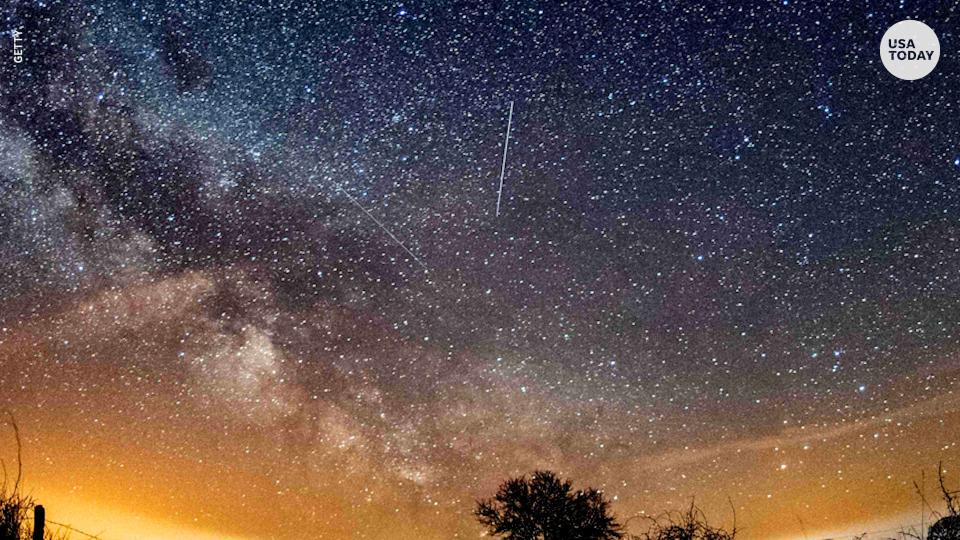One of the oldest-known meteor showers starts this week. Here's how you can see it in Wisconsin
One of the oldest-known meteor showers, the Lyrids, will peak in late April across the Northern Hemisphere. The Lyrids are known for their fast and bright meteors, and NASA says they could surprise sky-watchers with as many as 100 meteors per hour.
And while you could only see the April 8 solar eclipse in North America, the Lyrids will be visible across the world. Here's how to catch a glimpse of the meteor shower, and when it will peak in 2024:
When is the Lyrid meteor shower?
The Lyrids will next peak between April 21 to 22 this year and is active from April 15 to 29. While NASA says that the Lyrids can have as many as 100 meteors per hour, generally 10 to 20 meteors can be seen per hour during their peak.
Will the Lyrid meteor shower be visible in Wisconsin?

Yes. These meteors are best seen from the Northern Hemisphere, but activity from this shower can be seen from the Southern Hemisphere just at a lower rate.
What causes the Lyrid meteor shower?
Meteor showers happen when the Earth passes through debris trails left by comets. The debris collides with our atmosphere and forms fiery and colorful streaks in the sky, according to NASA.
Specifically, the Lyrids are pieces of debris from the Comet C/1861 G1 Thatcher. The Earth passes through the stream of debris from the comet every April, which causes the meteor shower. The Lyrids don't usually leave a long, glowing dust train behind them in the sky, but can produce an occasional bright flash, known as a fireball.
Tips on how to view a meteor shower:
The Lyrids are best viewed in the Northern Hemisphere at night. The best conditions to see the night sky will be with clear skies without clouds or haze. Make sure to check the forecast before heading out.
Here's a list of places in Wisconsin that could offer some of the best views of the night sky:
Newport State Park, Ellison Bay
RELATED: Biggest astronomical events in 2024: Eclipses to meteor showers and full moon schedule
Meteor shower 2024 schedule:
Here's a list of the meteor showers to add to your calendar:
April 21-22: Lyrid meteor shower has an average of 10 meteors per hour in dark skies. This shower is visible from both the Northern and Southern Hemisphere, but is more active in the Northern Hemisphere.
May 4-5: Eta Aquariid meteor shower is bigger in the Southern Hemisphere where the meteor's radiant is higher in the sky. The shower is usually seen closer to the horizon in the Northern Hemisphere.
July 29-30: Delta Aquariid meteor shower usually produces between 10 and 20 meteors per hour.
Aug. 11-13: Perseid meteor shower features over 50 meteors at its peak.
Oct. 8-9: Draconids meteor shower mark the start of a season of meteor showers. After the Draconids, a shower occurs every one to two weeks until late December.
Oct. 21-22: Orionid meteor shower features some of the brightest and fastest streaking stars.
Nov 8-9: Taurid meteor shower is a weaker shower with only a few meteors seen each night.
Nov. 17-18: Leonid meteor shower typically has 10 to 15 shooting starts per hour, but sometimes has been known to produce "meteor storms," which result in thousands of meteors streaking the sky.
Dec. 13-14: Geminid meteor shower is the biggest meteor shower of the year and can produce 75 meteors per hour at its peak.
Dec. 21-22: Ursid meteor shower is visible in the Northern Hemisphere as the radiant is too far north of the equator for good viewing in the Southern Hemisphere.
RELATED: When will the next total solar eclipse happen in Wisconsin after 2024?
This article originally appeared on Milwaukee Journal Sentinel: Lyrid meteor shower 2024: How to see it in Wisconsin, when it peaks
